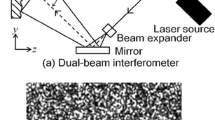Abstract
For measuring small deformations in large structures by electronic speckle pattern interferometry (ESPI), the increase of laser power is required for providing the sufficient laser power per area. However, high-power lasers lead increasing the risk of exposure to laser, the size of the equipment and the cost. In this study, ESPI with line laser scanning is investigated for large area deformation measurements without increasing the laser power. A dual-beam interferometer for a horizontal displacement measurement which can illuminate horizontal line lasers and can scanning for vertical direction is constructed. A static in-plane deformation of an aluminum sheet specimen is measured. Speckle images for each vertical position are captured at the initial and the deformed state. Analyzed phase maps for each line show mismatch of the phases. Additionally, a method for integrating the mismatched line phase maps are investigated.
Access provided by CONRICYT-eBooks. Download conference paper PDF
Similar content being viewed by others
Keywords
15.1 Introduction
For measuring surface deformations, optical or interferometric techniques are effective. Especially, electronic speckle pattern interferometry (ESPI) [1, 2] is very useful for measuring elastic deformations or thermal deformations because of the high sensitivity. When large area is measured by ESPI, a high power laser source is required to ensure the sufficient laser power per area. It is expected that a very high power laser as watt level is required for meter order of the measurement area. High power lasers more than 0.5 watt is classified class 4 as the most dangerous level. It leads requirements of safety equipment and increasing the cost. Therefore, the development of the technique for large area deformation measurement by ESPI without increasing the laser power is effective for the usefulness. In this study, ESPI with line laser scanning for large area deformation measurements are investigated.
15.2 Electronic Speckle Pattern Interferometry with Line Laser Scanning
A schematic figure of a dual-beam interferometer for ESPI with line laser scanning is shown as Fig. 15.1. The line shaped interference region is made on the object surface using cylindrical lenses and can scan the object surface by moving the interferometer. Image capturing at the same scanning positions before and after the deformation are required. Additionally, an investigation of the method for integrating the line interferograms. Figure 15.2 shows a schematic of the image integration. Phase mismatches occur by environmental vibrations. Therefore, the phase correction for the image integration is necessary. In this study, phase values in overlap regions arranged between adjacent lines are compared. The line phases are then corrected and integrated.
15.3 Experiment
A dual-beam interferometer for a horizontal displacement measurement which can illuminate horizontal line lasers and can scanning for vertical direction is constructed on an experimental stage. The laser power is 53 mW and the wavelength is 633 nm. The beam diameter for vertical axis is 1.42 mm. The width of the interference region expanded by the cylindrical lenses is about 50 mm. A monochrome CCD camera is used for measurement. A measurement of a static horizontal tensile deformation of an aluminum sheet specimen is carried out. The camera is fixed on the experimental stage while the measurement with laser scanning.
15.4 Results and Discussion
Line shaped interferograms showing the tensile deformation were obtained. Hence the accurate laser scanning could be performed. Analyzed phase maps for each line showed the mismatch of the phases. The phase correction was performed. The corrected phases were then integrated as a single phase map. The integrated phase map showed a continuous phase distribution. Therefore the phase correction was effective. However, slight phase mismatches observed on the integrated phase map with phase correction when the scanning steps increased. It is expected that the deformation slightly occurs while the measurement. The proposed method can only be used for static deformation measurement. However, a comparatively long time was taken for the line laser scanning and the phase shift for the phase analysis because of the hand movement at this stage. Therefore, the deformation increased during the measurement. For minimizing the deformation during the measurement, speeding up the measurement process by an automation is required.
15.5 Conclusion
In this study, ESPI with line laser scanning was investigated for large area deformation measurements without increasing the laser power. A dual-beam interferometer for a horizontal displacement measurement which can illuminate horizontal line lasers and can scanning for vertical direction was constructed. A static in-plane deformation of an aluminum sheet specimen was measured. Speckle images for each vertical position were captured at the initial and the deformed state. Analyzed mismatch phases were corrected and integrated. As the result, accurate laser scanning could be performed. The continuous phase distribution was obtained by the image integration with the phase correction. Therefore, the proposed method is effective. Additionally, for increasing the scanning steps, speeding up the measurement process by an automation is necessary.
Reference
Chiang, F.P.: Speckle Metrology, ASM Handbook Volume 17, Nondestructive Evaluation and Quality Control, pp. 432–437. ASM International, OH, USA (1989)
Sirohi, R.S.: Speckle interferometry. Contemp. Phys. 43(3), 161–180 (2002)
Author information
Authors and Affiliations
Corresponding author
Editor information
Editors and Affiliations
Rights and permissions
Copyright information
© 2018 The Society for Experimental Mechanics, Inc.
About this paper
Cite this paper
Arikawa, S., Ando, Y. (2018). Investigation of Electronic Speckle Pattern Interferometry with Line Laser Scanning for Large Area Deformation Measurement. In: Lamberti, L., Lin, MT., Furlong, C., Sciammarella, C. (eds) Advancement of Optical Methods in Experimental Mechanics, Volume 3. Conference Proceedings of the Society for Experimental Mechanics Series. Springer, Cham. https://doi.org/10.1007/978-3-319-63028-1_15
Download citation
DOI: https://doi.org/10.1007/978-3-319-63028-1_15
Published:
Publisher Name: Springer, Cham
Print ISBN: 978-3-319-63027-4
Online ISBN: 978-3-319-63028-1
eBook Packages: EngineeringEngineering (R0)






